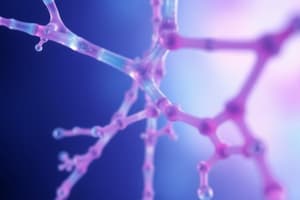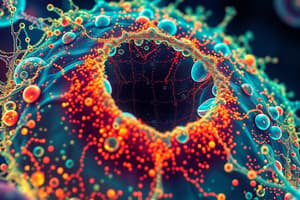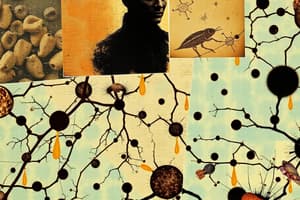Podcast
Questions and Answers
What is the primary function of microtubules within a cell?
What is the primary function of microtubules within a cell?
- Provide shape and movement
- Act as tracks for intracellular transport (correct)
- Give mechanical support
- Facilitate transcription
Which process occurs in the cytosol?
Which process occurs in the cytosol?
- Translation (correct)
- DNA synthesis
- Transcription
- DNA replication
What is the role of telomerase in DNA replication?
What is the role of telomerase in DNA replication?
- Extends the 3’ end of the lagging strand (correct)
- Catalyzes the formation of hydrogen bonds
- Synthetizes RNA primers
- Replaces RNA primers with DNA
What type of bonds connect adenine and thymine in DNA?
What type of bonds connect adenine and thymine in DNA?
What is the correct order of the flow of genetic information in the central dogma of molecular biology?
What is the correct order of the flow of genetic information in the central dogma of molecular biology?
What problem arises during the replication of the lagging strand?
What problem arises during the replication of the lagging strand?
What component of DNA provides its structural integrity?
What component of DNA provides its structural integrity?
How are the two DNA strands oriented relative to one another?
How are the two DNA strands oriented relative to one another?
What role do cohesins play during cell division?
What role do cohesins play during cell division?
Which stage of mitosis is characterized by the alignment of chromosomes at the metaphase plate?
Which stage of mitosis is characterized by the alignment of chromosomes at the metaphase plate?
What is the primary function of the kinetochores during cell division?
What is the primary function of the kinetochores during cell division?
What triggers the separation of chromatids during anaphase?
What triggers the separation of chromatids during anaphase?
In which phase do the centrosomes migrate to opposite sides of the nucleus?
In which phase do the centrosomes migrate to opposite sides of the nucleus?
How does cytokinesis differ between animal and plant cells?
How does cytokinesis differ between animal and plant cells?
Which of the following microtubules provides structural integrity to the mitotic spindle?
Which of the following microtubules provides structural integrity to the mitotic spindle?
What happens during telophase in mitosis?
What happens during telophase in mitosis?
What is the primary function of a promoter in gene expression?
What is the primary function of a promoter in gene expression?
Which component is part of eukaryotic gene regulation but not prokaryotic?
Which component is part of eukaryotic gene regulation but not prokaryotic?
In the context of the Lac Operon, what role does glucose play?
In the context of the Lac Operon, what role does glucose play?
What is the role of enhancers in eukaryotic gene regulation?
What is the role of enhancers in eukaryotic gene regulation?
How do repressors function in prokaryotic gene regulation?
How do repressors function in prokaryotic gene regulation?
What is the significance of enhancers in the evolution of vertebrate body plans?
What is the significance of enhancers in the evolution of vertebrate body plans?
Which of the following accurately describes the Mediator complex in eukaryotic gene expression?
Which of the following accurately describes the Mediator complex in eukaryotic gene expression?
What happens to transcription when lactose is present in the environment of a bacterium using the Lac Operon?
What happens to transcription when lactose is present in the environment of a bacterium using the Lac Operon?
What is the primary significance of Hox genes across bilaterally symmetric animals?
What is the primary significance of Hox genes across bilaterally symmetric animals?
What role do maternal inputs play in zygotic gene expression?
What role do maternal inputs play in zygotic gene expression?
Which of the following represents the role of VegT in embryonic development?
Which of the following represents the role of VegT in embryonic development?
How does fertilization influence the development in Xenopus laevis?
How does fertilization influence the development in Xenopus laevis?
What happens at the animal pole of Xenopus laevis during development?
What happens at the animal pole of Xenopus laevis during development?
What is the primary function of the Spemann-Mangold Organizer (SMO) in vertebrate body plan establishment?
What is the primary function of the Spemann-Mangold Organizer (SMO) in vertebrate body plan establishment?
Which mechanism assists in moving Wnt11 to the future dorsal side during cortical rotation?
Which mechanism assists in moving Wnt11 to the future dorsal side during cortical rotation?
What does the marginal zone, or equatorial region, become during development?
What does the marginal zone, or equatorial region, become during development?
What is the primary role of tight junctions in epithelial cells?
What is the primary role of tight junctions in epithelial cells?
What type of junction connects actin filaments of adjacent cells?
What type of junction connects actin filaments of adjacent cells?
What property do cadherins depend on for their cell-cell adhesion function?
What property do cadherins depend on for their cell-cell adhesion function?
Which of the following components do integrins connect to the cytoskeleton?
Which of the following components do integrins connect to the cytoskeleton?
What occurs during the epithelial-mesenchymal transition (EMT)?
What occurs during the epithelial-mesenchymal transition (EMT)?
Which of the following best describes the role of cadherins in neural tube formation?
Which of the following best describes the role of cadherins in neural tube formation?
What is NOT a function of the extracellular matrix (ECM)?
What is NOT a function of the extracellular matrix (ECM)?
Which type of junction is primarily responsible for cell communication?
Which type of junction is primarily responsible for cell communication?
What role does Wnt11 play in the formation of the Spemann-Mangold Organizer?
What role does Wnt11 play in the formation of the Spemann-Mangold Organizer?
What happens when the Spemann-Mangold Organizer is transplanted?
What happens when the Spemann-Mangold Organizer is transplanted?
How do inhibitors like Chordin and Noggin function in the context of the organizer?
How do inhibitors like Chordin and Noggin function in the context of the organizer?
What does high BMP activity generally lead to in terms of tissue structure?
What does high BMP activity generally lead to in terms of tissue structure?
Which of the following statements is accurate regarding the evolutionary conservation in vertebrates?
Which of the following statements is accurate regarding the evolutionary conservation in vertebrates?
Which cellular behaviors are essential for morphogenesis?
Which cellular behaviors are essential for morphogenesis?
What characterizes epithelial cells compared to mesenchymal cells?
What characterizes epithelial cells compared to mesenchymal cells?
What is one of the main roles of the organizer during development?
What is one of the main roles of the organizer during development?
Flashcards
Cohesins
Cohesins
Proteins that bind sister chromatids together during mitosis, ensuring accurate chromosome separation.
Centrosomes
Centrosomes
The duplicated 'anchors' for spindle fibers in mitosis, consisting of two centrioles.
Astral Microtubules
Astral Microtubules
Microtubules that extend outward from the centrosomes during mitosis, helping to position the spindle within the cell.
Kinetochore Microtubules
Kinetochore Microtubules
Signup and view all the flashcards
Interpolar Microtubules
Interpolar Microtubules
Signup and view all the flashcards
Prophase
Prophase
Signup and view all the flashcards
Prometaphase
Prometaphase
Signup and view all the flashcards
Metaphase
Metaphase
Signup and view all the flashcards
DNA Replication: What is it?
DNA Replication: What is it?
Signup and view all the flashcards
DNA Polymerase: The Builder
DNA Polymerase: The Builder
Signup and view all the flashcards
Primer: The Starter
Primer: The Starter
Signup and view all the flashcards
Leading Strand: Continuous Synthesis
Leading Strand: Continuous Synthesis
Signup and view all the flashcards
Lagging Strand: Fragmentation
Lagging Strand: Fragmentation
Signup and view all the flashcards
Telomerase: Protecting Ends
Telomerase: Protecting Ends
Signup and view all the flashcards
Central Dogma of Molecular Biology: Flow of Information
Central Dogma of Molecular Biology: Flow of Information
Signup and view all the flashcards
Proteins: The Workers
Proteins: The Workers
Signup and view all the flashcards
Promoter
Promoter
Signup and view all the flashcards
Terminator
Terminator
Signup and view all the flashcards
Regulators (Repressors & Activators)
Regulators (Repressors & Activators)
Signup and view all the flashcards
Lac Operon
Lac Operon
Signup and view all the flashcards
RNA Polymerase II
RNA Polymerase II
Signup and view all the flashcards
Promoters (e.g., TATA box)
Promoters (e.g., TATA box)
Signup and view all the flashcards
Enhancers
Enhancers
Signup and view all the flashcards
Mediator Complex
Mediator Complex
Signup and view all the flashcards
Tight Junctions
Tight Junctions
Signup and view all the flashcards
Gap Junctions
Gap Junctions
Signup and view all the flashcards
Adherens Junctions
Adherens Junctions
Signup and view all the flashcards
Desmosomes
Desmosomes
Signup and view all the flashcards
Hemidesmosomes
Hemidesmosomes
Signup and view all the flashcards
Extracellular Matrix (ECM)
Extracellular Matrix (ECM)
Signup and view all the flashcards
Integrins
Integrins
Signup and view all the flashcards
Wnt11
Wnt11
Signup and view all the flashcards
Vegetal Pole
Vegetal Pole
Signup and view all the flashcards
VegT
VegT
Signup and view all the flashcards
Spemann-Mangold Organizer (SMO)
Spemann-Mangold Organizer (SMO)
Signup and view all the flashcards
Kinesin
Kinesin
Signup and view all the flashcards
Cortical Rotation
Cortical Rotation
Signup and view all the flashcards
Nodal
Nodal
Signup and view all the flashcards
Xenopus laevis
Xenopus laevis
Signup and view all the flashcards
Morphogenesis
Morphogenesis
Signup and view all the flashcards
Epithelial cells
Epithelial cells
Signup and view all the flashcards
Mesenchymal cells
Mesenchymal cells
Signup and view all the flashcards
BMP4
BMP4
Signup and view all the flashcards
Chordin and Noggin
Chordin and Noggin
Signup and view all the flashcards
Mechanism of dorsal-ventral axis formation
Mechanism of dorsal-ventral axis formation
Signup and view all the flashcards
Study Notes
Cell Biology Overview
- Lecture 2 provides a detailed overview of cell biology fundamentals, including the discovery of cells, cell theory, microscopy, and organelles.
Discovery of Cells and Cell Theory
- Invention of the microscope in the 17th century led to the discovery of cells.
- All living organisms are made of cells.
- Cells are the basic unit of life.
- Cells arise from pre-existing cells.
- Hereditary information passes from cell to cell.
- All cells have the same basic chemical composition.
- Energy flow occurs within cells.
Cell Sizes and Microscopy
- Small bacteria: ~1 µm.
- Typical vertebrate cells: ~10 μm.
- Organelles: 1-2 μm.
- Ribosomes: ~25 nm.
- Light Microscope: Resolution ~0.2 µm; used for observing cells and larger organelles.
- Transmission Electron Microscopy (TEM): Resolution ~nm; reveals fine cellular details like ribosomes.
- Immunofluorescence Microscopy: Detects specific proteins in cells.
- GFP Tagging: Revolutionized cell biology by allowing protein localization in living cells.
Prokaryotes vs. Eukaryotes
- Prokaryotes: Include bacteria and archaea.
- Eukaryotes: Include fungi, animals, and plants.
- Genetic material in prokaryotes is in the cytoplasm, while eukaryotes enclose genetic material in a nucleus with a double membrane.
- Eukaryotes have membrane-bound organelles for specialized functions.
Organelles and Their Functions
- Nucleus: Double membrane with nuclear pores for molecular exchange; encloses DNA.
- Mitochondria: Double membrane organelles producing ATP; evolved from engulfed bacteria, contain their own DNA.
- Chloroplasts: Found in plants and algae; use light energy to produce energy-rich molecules while consuming CO2 and releasing O2, evolved from photosynthetic bacteria.
- Endoplasmic Reticulum (ER): Synthesizes lipids and proteins for secretion.
- Golgi Apparatus: Modifies, sorts, and packages proteins and lipids for secretion or use within the cell.
- Cytosol: Surrounds organelles, accounting for ~50% of cell volume; site of many biochemical reactions, including protein synthesis.
- Cytoskeleton: Cellular framework made of microfilaments (actin filaments), microtubules, and intermediate filaments; essential for cell shape, structural integrity, and internal organization.
Central Dogma of Molecular Biology
- DNA --> RNA --> Protein
- Replication, transcription, and translation occur in the cell
- Replication and Transcription: Occur in the nucleus.
- Translation: Occurs in the cytosol.
Cellular Composition
- Cells are ~70% water.
- Major macromolecules include proteins (~15%), RNA (~6%), and DNA (~1%).
- Other components: Polysaccharides and phospholipids (~4%).
- Small molecules (~4%).
DNA Structure and Synthesis
- DNA is made of deoxynucleotides (bases + deoxyribose + phosphate).
- Bases: Pyrimidines (Cytosine, Thymine) – single rings; Purines (Adenine, Guanine) – double rings.
- DNA strands have polarity: 5' End: Phosphate group; 3' End: Free hydroxyl (-OH) group.
Other key concept summaries
- Additional lectures cover RNA, transcription, protein folding and structure, protein synthesis, and the role of organelles in these cellular processes
Studying That Suits You
Use AI to generate personalized quizzes and flashcards to suit your learning preferences.




